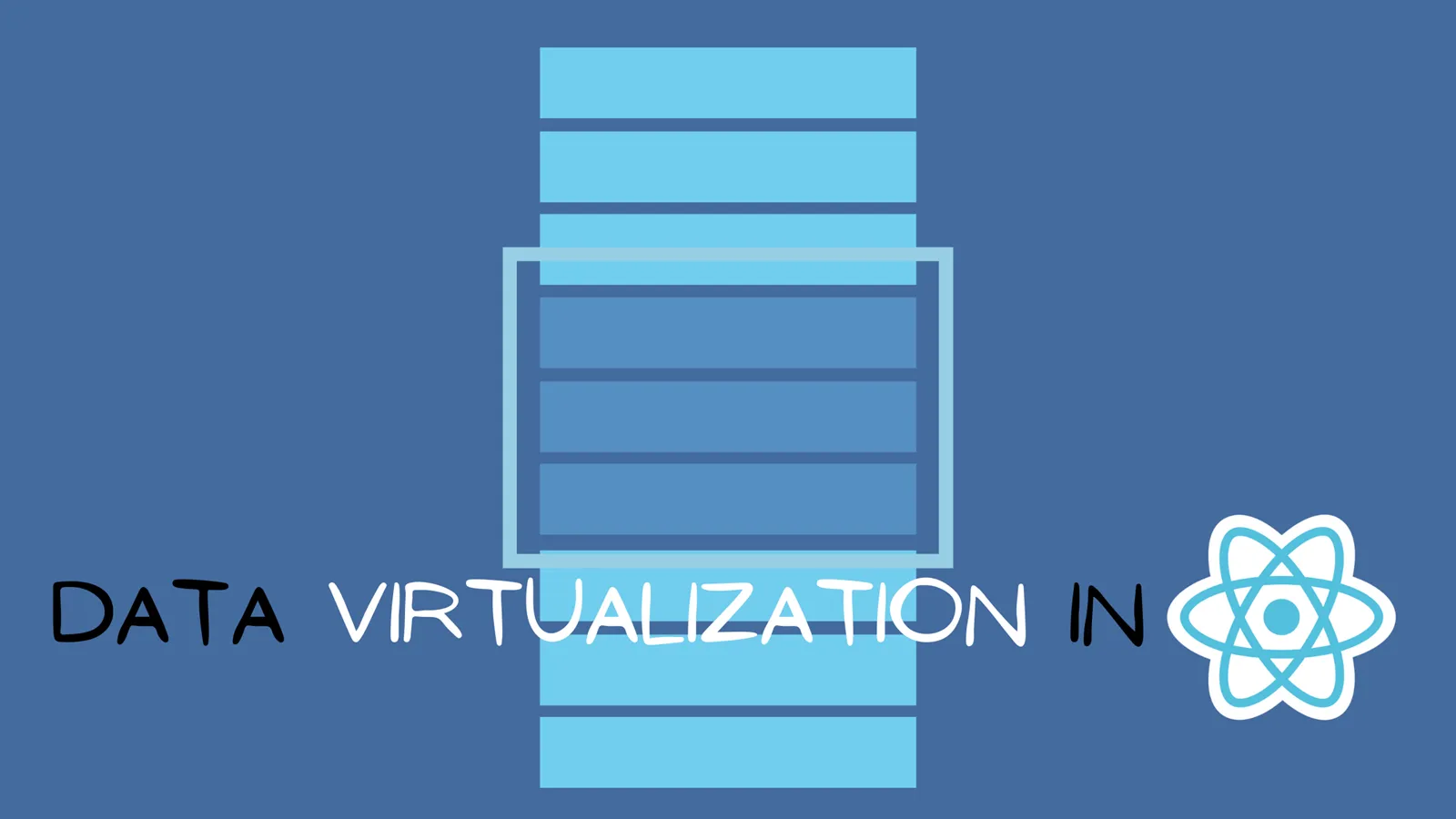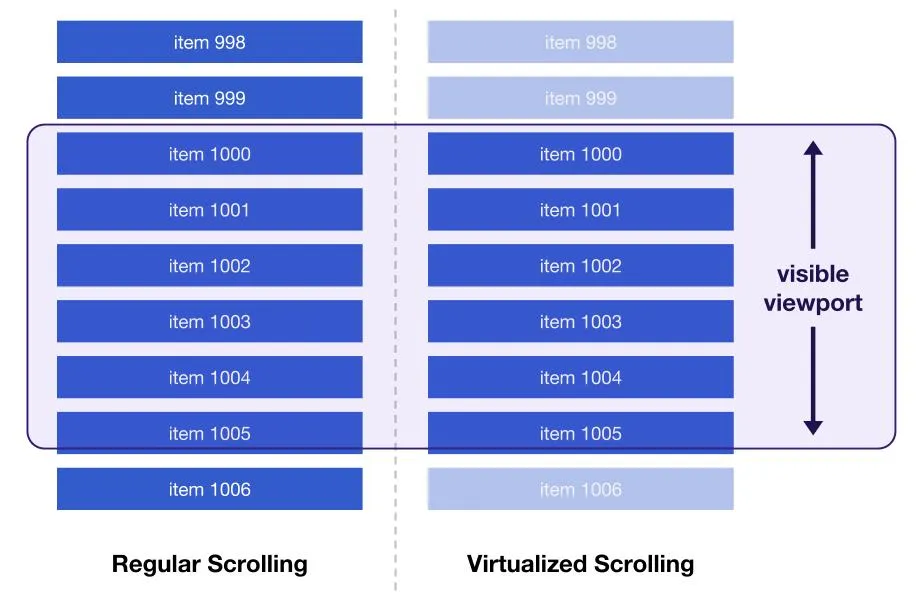In modern web application development, displaying huge data lists—from tables with thousands of rows, endless news feeds, to long friend lists—is a real challenge. If not handled properly, it can turn a smooth app into a sluggish "turtle," resulting in a poor user experience. This is where Virtualization (also known as "windowing") shines as a true performance savior.

So what is Virtualization, and how can it be a game-changer for React performance? Let’s dive deeper in this article! 🚀
The Core Problem: Why Do Long Lists Kill Performance?
Imagine you have a list of 10,000 items to display. The typical approach in React is to use the map() function to iterate through the entire data array and render 10,000 child components into the DOM.
function MyBigList({ items }) {
return (
<ul>
{items.map((item) => (
<li key={item.id}>{item.name}</li>
))}
</ul>
)
}
This approach seems simple but hides a ticking time bomb for performance:
- Too many DOM nodes: The browser has to create and manage thousands or even tens of thousands of DOM nodes, which is extremely memory and CPU intensive.
- Slow initial render: React must reconcile all 10,000 components, making the first load very slow.
- Sluggish interactions: Even a small update (e.g., changing the state of one item) can force React to check the entire huge DOM tree, causing laggy scrolling or interactions.
As a result, your app will consume a lot of RAM, heat up the user's device, and deliver an unacceptable experience.
Virtualization: The Principle of "Only Render What You See"
Virtualization is a smart technique that solves the above problem with a simple principle: only render the items that are actually visible in the user's viewport, plus a few buffer items above and below.

Imagine looking through a window at a very long list. You only see a few items through that window. Virtualization works similarly:
- Calculate space: It computes the total height of the entire list (based on the number of items and the height of each item).
- Create a scrollable "window": It creates a large scrollable container with a virtual height equal to the total calculated height.
- Render only what's needed: It only renders components for the items currently visible in the "window."
- Update on scroll: As the user scrolls, the library recalculates which items are in view and swaps out old components for new ones, updating their positions in the container.
This way, instead of rendering 10,000 components, your app may only render about 10-20 components at any given time—a massive performance boost!
Popular Libraries for Virtualization
In the React ecosystem, there are several powerful libraries to help you implement Virtualization easily. The two most popular are React Window and React Virtualized.
1. React Window: Lightweight and Efficient
react-window is considered the lighter, faster successor to react-virtualized. It was rewritten from scratch with a focus on performance and small bundle size. It's a great choice for most use cases.
Key components:
FixedSizeList: For lists where every item has the same height (or width).VariableSizeList: For lists where items have different heights (or widths).FixedSizeGrid: For two-dimensional grids with fixed-size cells.VariableSizeGrid: For grids with variable-size cells.
Example with FixedSizeList:
import { FixedSizeList as List } from 'react-window'
const Row = ({ index, style }) => <div style={style}>Row {index}</div>
const MyVirtualizedList = () => (
<List
height={400} // Height of the viewport
itemCount={10000} // Total number of items
itemSize={50} // Height of each item
width={300} // Width of the viewport
>
{Row}
</List>
)
In this example, react-window will only render about 8-9 Row components (400 / 50) to the DOM, instead of 10,000. Super efficient!
2. React Virtualized: Feature-Rich
react-virtualized is a powerful "older sibling" library with more features. It includes ready-made components like Table, Grid, List, Collection, and Masonry. If you need more complex features that react-window doesn't support, this is a solid choice.
However, its versatility comes with a larger bundle size and a bit more complexity.
When Should You Use Virtualization?
This is an important question. You shouldn't always apply this technique. Consider using Virtualization when:
- You have a very long list: As a rule of thumb, when your list has several hundred items or more.
- Performance is a top priority: Your app needs to be smooth and responsive even with large data sets.
- List items are complex: If each item is a complex component with lots of logic and DOM nodes, the benefits of Virtualization are even greater.
Note: For short lists (under 100 items), Virtualization may be unnecessary and could even complicate your codebase.
Challenges and Advanced Tips
While powerful, Virtualization comes with some caveats:
- Dynamic Height: Handling lists where items have variable heights (e.g., comments that can be 1 or 10 lines) is more complex. You may need to measure or estimate each item's height. Libraries like
react-virtualizedoffer aCellMeasurercomponent for this. - Accessibility: Items not in the DOM won't be recognized by assistive technologies (like screen readers). You need proper ARIA techniques to ensure accessibility.
- Search (Ctrl+F): The browser's default search won't work for content not rendered. You'll need to implement your own search functionality in your app.
- Using
react-window-infinite-loader: When combining Virtualization with infinite loading, this library helps you manage loading new items as the user scrolls near the end of the list.
Conclusion: Virtualization is a Powerful Technique
Virtualization isn't a silver bullet for every performance problem, but it's an essential technique in every React developer's toolkit. By applying the "only render what you see" principle, it enables us to build apps that handle massive data sets smoothly and efficiently, delivering the best user experience.
Next time you face an endless list, don't hesitate—remember Virtualization, the silent hero of performance. Happy coding! ✨
![[Advanced React] Virtual DOM in React: The Foundation of Performance and How It Works](/images/blog/virtual-dom-in-react.webp)
![[Advanced React] React Concurrent Mode: Taking App Performance to the Next Level](/images/blog/react-concurrent-mode.webp)
![[Advanced React] Micro-Frontends Architecture: A Solution for Large Web Apps](/images/blog/micro-frontends-architecture.webp)
![[React Basics] Rendering Lists in React: Best Practices and Performance Optimization](/images/blog/rendering-lists-in-react.webp)